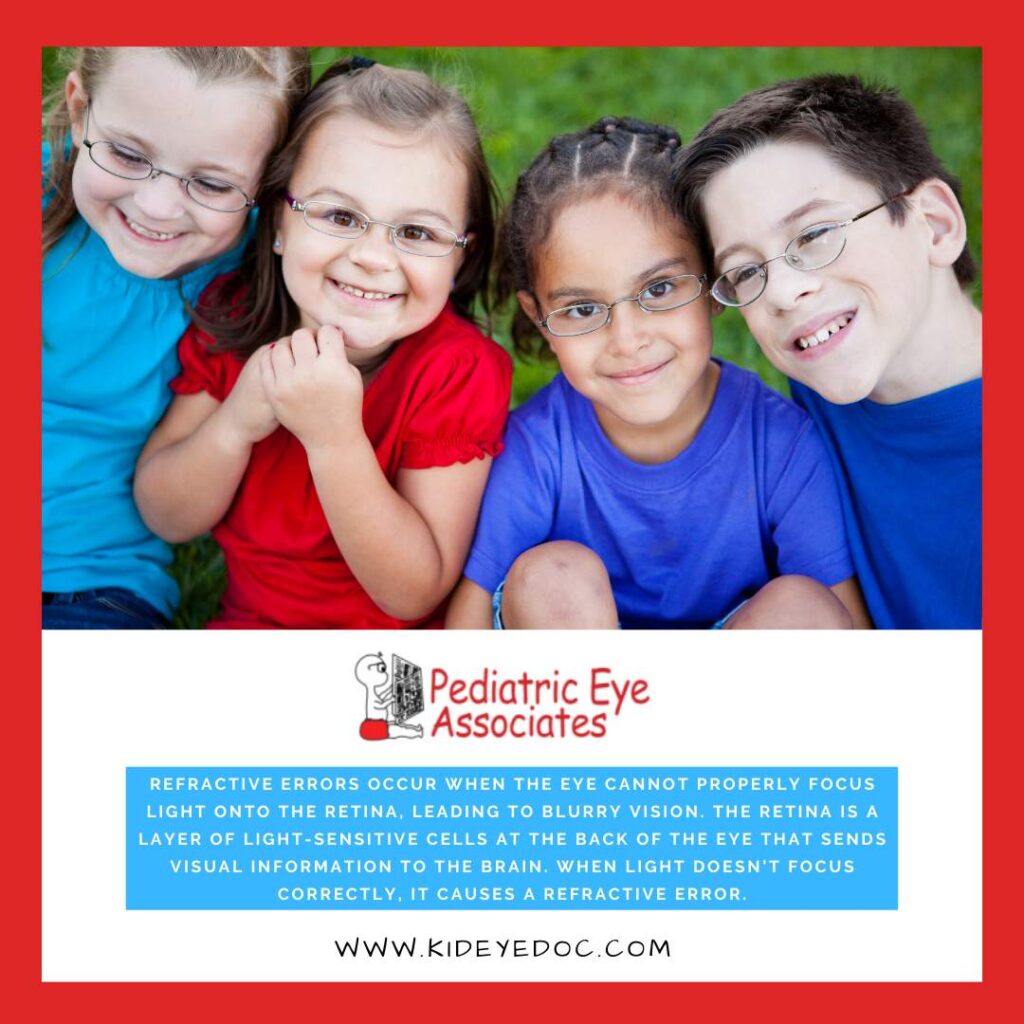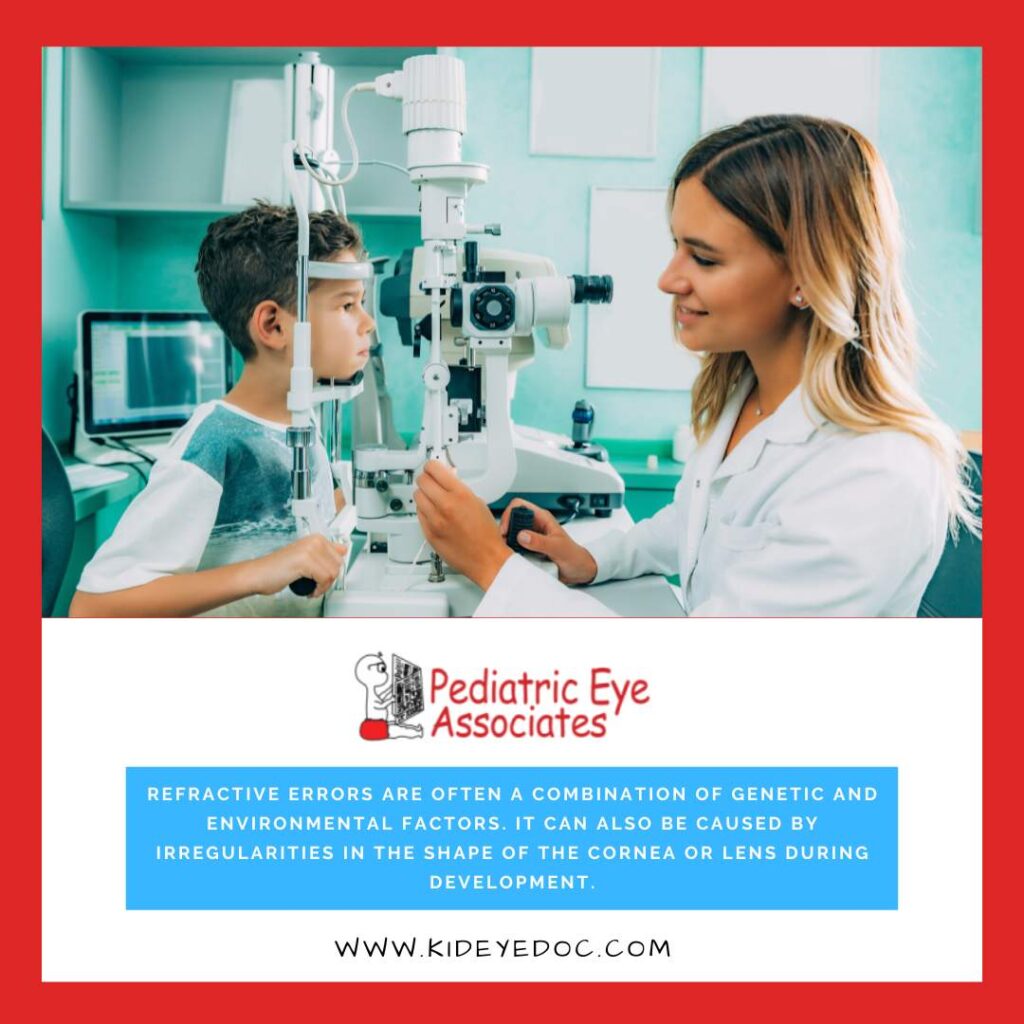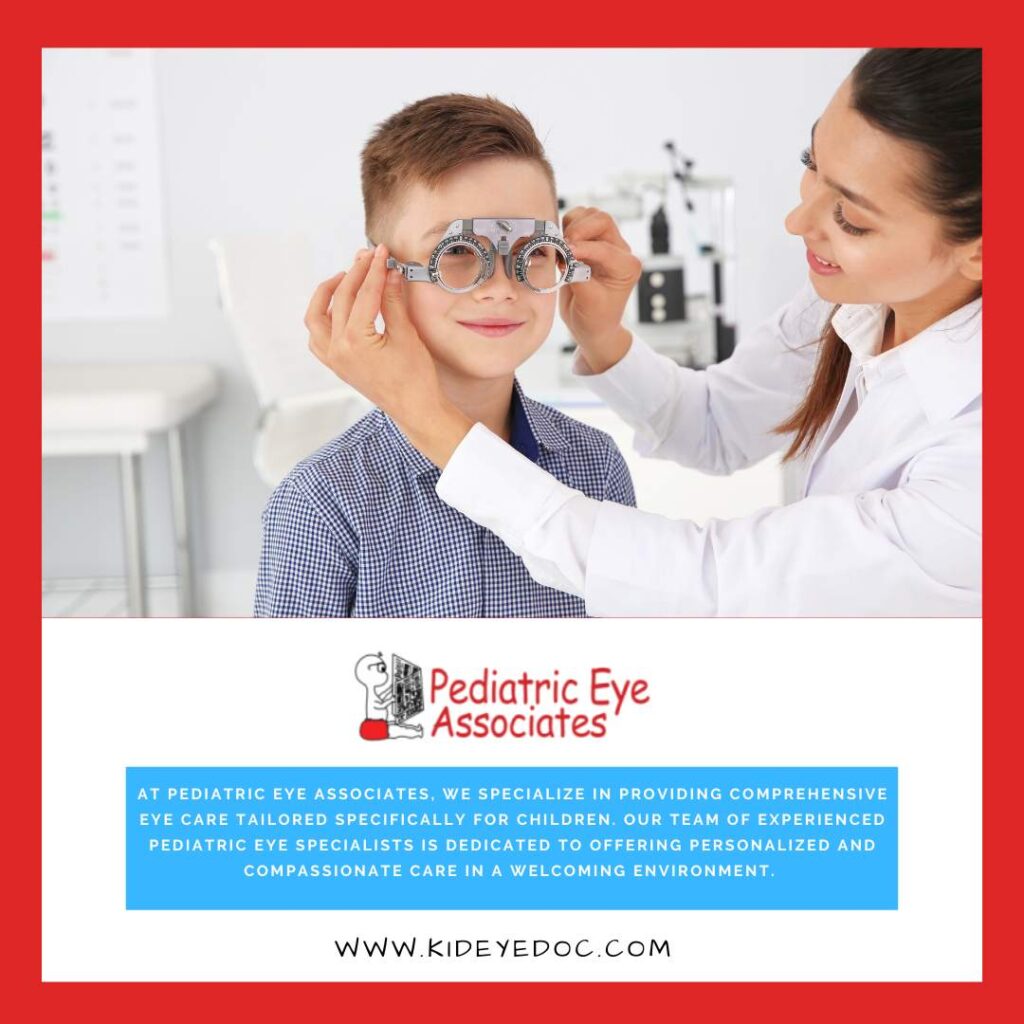Good eyesight plays a crucial role in learning, social development, and daily activities. Unfortunately, as discussed in our previous article, many children experience vision problems, such as impaired eye alignment and convergence issues.
Of course, as anyone with glasses can attest to, these are hardly the only eye problems children can have. Refractive errors are another common vision problem that can hinder your child’s ability to see clearly.

In today’s article, we’ll tell you more about refractive errors – what you probably know as nearsightedness, farsightedness and astigmatism.
What are refractive errors?
Refractive errors occur when the eye cannot properly focus light onto the retina, leading to blurry vision. The retina is a layer of light-sensitive cells at the back of the eye that sends visual information to the brain. When light doesn’t focus correctly, it causes a refractive error.
There are several types of refractive errors that commonly affect children: myopia, hyperopia, astigmatism, and anisometropia.
What is important to know is that most children are naturally somewhat farsighted – they can see better at long distances than adults. Myopia and astigmatism in young children are less common.
In fact, there seems to be a connection between the amount of time children spend outdoors in natural light and their propensity to develop myopia.
- Myopia – Nearsightedness
Myopia means that the eye is a bit longer than usual or has a steep cornea, which results in the light focusing in front of the retina. It means that close objects look clear, and distant objects are blurry. Some of the telltale signs that your child is nearsighted include:
- Squinting to see distant objects clearly
- Difficulty reading the board in class or seeing street signs
- Complaints of headaches or eye strain after reading
Causes of myopia
Children whose parents have myopia are more likely to develop it; however, both parents can have perfect vision, and their children can still develop myopia.
Some researchers suspect that reading for long periods or holding books too close to your eyes may increase the risk of myopia, but there is no conclusive evidence of this.
Treatment and management of myopia
Your children’s eye doctor can do a vision exam and prescribe eyeglasses or contact lenses to treat myopia.
In some cases, laser surgery or other procedures may be considered for older children or adults with severe myopia.
- Hyperopia – Farsightedness
Just as a myopic eye is longer than usual, a hyperopic eye is shorter. That means light from close objects that should focus on the retina doesn’t – it would focus behind the retina instead.
What it means in practice is that when your child is trying to read a book or do an art project, he may have trouble seeing the page or doing the detailed work carefully. Other symptoms include:
- Difficulty focusing on objects up close, such as reading or writing
- Eye strain, headaches, or blurred vision
- Squinting or closing one eye to improve focus
Causes of hyperopia
Common causes of hyperopia in children include genetics and eye development issues. Farsightedness can also be connected to both amblyopia and strabismus, so it is important to get any suspicions checked out.

Treatment and management of hyperopia
Like for myopia, glasses and contacts can both be solutions for farsightedness because it helps to focus light correctly on the retina. However, each case is unique, so only your pediatric eye doctor can say for sure.
- Astigmatism
In astigmatism, the cornea is not perfectly round but curves more one way than the other. The result is a distorted and blurred vision for objects up close and far away. Some of the symptoms of astigmatism include:
- Complaints of blurred or distorted vision, whether near or far
- Frequent squinting or tilting the head to see better
- Eye discomfort or headaches after reading or watching screens
Causes of astigmatism
A family history of astigmatism can increase your child’s risk of having the condition. Irregularities in the shape of the cornea or lens during development, as well as injury to the eye, can also cause astigmatism.
Treatment and management of astigmatism
Glasses or contact lenses are typically prescribed to correct the uneven curvature of the cornea, helping children see clearly. Regular eye exams ensure the correct prescription as a child grows.
Some types of astigmatism improve over time without treatment, and children can even improve enough not to need glasses. However, this is a decision for your children’s eye doctor to make.
Since untreated astigmatism, just like untreated myopia or hyperopia, can affect your children in school, it’s important to make your child’s eye health a priority.
- Anisometropia
Anisometropia is a condition where the refractive power is different in each eye, causing one eye to see more clearly than the other. If left untreated, it can lead to amblyopia (lazy eye), where the brain starts to ignore the weaker eye. Its symptoms include:
- Difficulty judging distances or depth perception
- Squinting or closing one eye to see better
- A tendency to turn or tilt the head while focusing
Anisometropia can disrupt binocular vision, making it difficult for children to perform tasks that require depth perception, like sports or navigating steps. Early detection is essential to prevent the development of amblyopia.
Causes of anisometropia
Common causes include genetics, eye development issues, or injuries.
Treatment and management of anisometropia
Glasses or contact lenses with different prescriptions for each eye can balance the refractive power, ensuring both eyes work together properly. In some cases, patching the stronger eye may be recommended to encourage the weaker eye to improve.
Importance of early detection and regular eye exams
Early detection of refractive errors is crucial in preventing long-term vision problems. Children might not always recognize or communicate vision difficulties, assuming everyone sees the world as they do. That’s why routine eye exams are essential, starting from infancy and continuing through childhood.

The American Optometric Association (AOA) recommends a child’s first comprehensive eye exam around six months, then at age three, and before entering school. Regular follow-up exams help ensure that any vision changes are quickly addressed.
Pediatric Eye Associates: Clear Vision, Brighter Future
At Pediatric Eye Associates, we specialize in providing comprehensive eye care tailored specifically for children. Our team of experienced pediatric eye specialists is dedicated to offering personalized and compassionate care in a welcoming environment.
Make an appointment with our best pediatric optometrist and ophthalmologist today. Contact us, and we’ll make sure your child’s vision is healthy!
The material contained on this site is for informational purposes only and DOES NOT CONSTITUTE THE PROVIDING OF MEDICAL ADVICE, and is not intended to be a substitute for independent professional medical judgment, advice, diagnosis, or treatment. Always seek the advice of your physician or other qualified healthcare providers with any questions or concerns you may have regarding your health.
